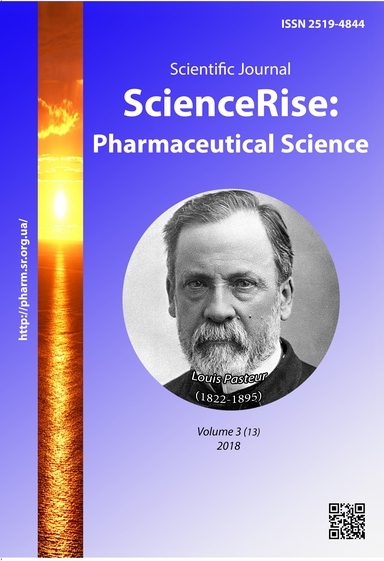Фармакоекономічний аналіз застосування раміприлу та кандесартану у хворих на артеріальну гіпертензію
DOI:
https://doi.org/10.15587/2519-4852.2018.135771Ключові слова:
артеріальна гіпертензія, кандесартан, раміприл, фарамакоекономічний аналіз, гіпотензивні препарати, затрати-ефективністьАнотація
Артеріальна гіпертензія (АГ) – найпоширеніше в світі серцево-судинне захворювання і є причиною інвалідизації населення розвинених країн світу. Особливістю фармакотерапії при АГ є довічний прийом лікарських препаратів. Показники економічної оцінки ефективності різних методів лікування сприяють вибору фармакотерапії, яка забезпечить пацієнту найбільшу результативність лікування з урахуванням фінансових можливостей конкретного хворого. Головними завданням антигіпертензивної терапії є досягнення цільового рівня артеріального тиску (АТ), захист органів-мішеней і позитивний вплив на фактори ризику серцево-судинних ускладнень. Метод «затрати-ефективність» дає можливість співставити витрати при однаковій терапевтичній ефективності, що і було метою нашого дослідження.
Матеріали та методи. Досліджено 100 протоколів медичних карток стаціонарних хворих. Виділено 2 групи хворих: перша група для лікування АГ отримувала кандесартан, а друга група – раміприл. До уваги бралися параметри: досягнення цільового АТ, а також можливі ускладнення лікарської терапії – гіпотензія, кашель, ангіоневротичний набряк. Для оцінки вартості лікування на тлі застосування раміприлу та кандесартану був проведений фармакоекономічний аналіз «затрати-ефективність».
Результати дослідження. За допомогою методу „вартість-ефективність” було проведено аналіз раміприлу і кандесартану. Були розраховані мінімальні, середні та максимальні вартості разової, добової та курсової дози і розрахована вартість нормалізації АТ. Отримані нами дані свідчать про меншу вартість лікування раміприлом. Результати аналізу ефективності препаратів продемонстрували, що раміприл більш ефективний у досягненні цільового АТ, але відсоток побічних ефектів серед яких серцева недостатність і кашель був суттєво вищим. Отримані дані вказують на високу терапевтичну ефективність кандесартану і раміприлу, що дозволяє зробити висновки:
Висновки. Найбільш ефективним у досягненні цільового АТ був раміприл по зрівнянню з кандесартаном. Аналіз ефективності дії лікарських препаратів встановив, що раміприл має побічні ефекти і викликає кашель і серцеву недостатність, а кандесартан може стати причиною ангіоневротичного набряку і гіпотензії. В ході аналізу прямих затрат на лікування АГ, на основі діючих стандартів надання медичної допомоги хворим з АГ було встановлено, що найменш витратним є лікування раміприлом. Проведений аналіз ≪витрати – ефективність≫, продемонстрував, що найбільшою фармакоекономічною перевагою має раміприл
Посилання
- Vdovichenko, V. P., Goncharuk, V. V., Bronskaya, G. M., Korshak, T. A., Mahan'kova, T. V. (2014). Farmakoekonomicheskaya ocenka lekarstvennogo sredstva zokardis (zofenopril) na osnove metodiki «minimizacii zatrat». Medicinskie novosti, 6, 56–60.
- Yur'ev, A. S., Avksent'eva, M. V., Vorob'ev, P. A., Gorbunov, S. N. (2005). Metodicheskie podhody k formirovaniyu aktual'nyh indikatorov kachestva medicinskoy pomoshchi. Problemy standartizacii v zdravoohranenii, 8, 14–21.
- Nedogoda, S. V., Barykina, I. N., Salasyuk, A. S., Smirnova, V. O. (2016). Farmakoekonomicheskiy analiz ispol'zovaniya azilsartana medoksomila v lechenii myagkoy i umerennoy essencial'noy gipertenzii. RMZh, 12, 734–738.
- Yagudina, R. I., Serpik, V. G., Kulikov, A. Yu. (2014). Farmakoekonomika dlya organizatorov zdravoohraneniya. Algoritm prinyatiya resheniy na osnove farmakoekonomicheskoy ocenki. Farmakoekonomika: teoriya i praktika, 2 (1), 5–12.
- Tolordava, G. A., Arinina, E. E., Kulikov, A. Yu. (2016). Farmakoekonomicheskiy analiz lekarstvennogo sredstva fozinopril u bol'nyh s arterial'noy gipertenziey. Farmakoekonomika: teoriya i praktika, 4 (1), 70–78.
- Granger, C. B., McMurray, J. J., Yusuf, S., Held, P., Michelson, E. L., Olofsson, B. et. al. (2003). Effects of candesartan in patients with chronic heart failure and reduced left-ventricular systolic function intolerant to angiotensin-converting-enzyme inhibitors: the CHARM-Alternative trial. The Lancet, 362 (9386), 772–776. doi: http://doi.org/10.1016/s0140-6736(03)14284-5
- Sheik Uduman, M. S. T., Reddy, R. B., Punuru, P., Chakka, G., Karunakaran, G. (2016). Protective Role of Ramipril and Candesartan against Myocardial Ischemic Reperfusion Injury: A Biochemical and Transmission Electron Microscopical Study. Advances in Pharmacological Sciences, 2016, 1–7. doi: http://doi.org/10.1155/2016/4608979
- Nikolaev, N. A. (2009). Innovacionnaya antigipertenzivnaya terapiya v svete zavershennyh nauchnyh issledovaniy. Racional'naya Farmakoterapiya v Kardiologii, 2, 89–97.
- Vdovichenko, V. L., Goncharuk, V. V., Bronskaya, G. M., Korshak, T. A., Mahan'kova, T. V. (2014). Farmakoekonomicheskaya ocenka lekarstvennogo sredstva Zokardis (ezofenopril) na osnove metodiki minimizacii zatrat. Medicinskie novovsti, 6, 56–60.
- Korovina, E. V. (2015). Racional'noe naznachenie antigipertenzivnyh lekarstvennyh sredstv na osnove farmakoepidemiologicheskogo analiza. Volgograd, 36.
- Tolparov, G. V. (2016). Vliyanie blokatorov renin-angiotenzin-al'dosteronovoy sistemy na funkcional'noe sostoyanie pravogo zheludochka pri infarkte miokarda peredney stenki levogo zheludochka. Kubanskiy nauchniy medicinskiy vestnik, 3 (158), 126–129.
- Martynyuk, T. V., Chazova, I. E. (2017). Preimushchestva azilsartana medoksomila u pacientov s arterial'noy gipertoniey: kak pravil'no osushchestvit' vybor i optimizirovat' antigipertenzivnuyu terapiyu? Sistemnye gipertenzii, 14 (2), 30–35.
- Savarese, G., Costanzo, P., Cleland, J. G. F., Vassallo, E., Ruggiero, D., Rosano, G., Perrone-Filardi, P. (2013). A Meta-Analysis Reporting Effects of Angiotensin-Converting Enzyme Inhibitors and Angiotensin Receptor Blockers in Patients Without Heart Failure. Journal of the American College of Cardiology, 61 (2), 131–142. doi: http://doi.org/10.1016/j.jacc.2012.10.011
- Angeloni, E. (2016). Azilsartan medoxomil in the management of hypertension: an evidence-based review of its place in therapy. Core Evidence. doi: http://doi.org/10.2147/ce.s81776
- Hart, W. M., Rubio-Terres, C., Pajuelo, F., Juanatey, J. R. G. (2002). Cost-effectiveness of the treatment of heart failure with ramipril: a Spanish analysis of the AIRE study. European Journal of Heart Failure, 4 (4), 553–558. doi: http://doi.org/10.1016/s1388-9842(02)00087-9
##submission.downloads##
Опубліковано
Як цитувати
Номер
Розділ
Ліцензія
Авторське право (c) 2018 Alena Marushchak, Evgeniy Shorikov

Ця робота ліцензується відповідно до Creative Commons Attribution 4.0 International License.
Наше видання використовує положення про авторські права Creative Commons CC BY для журналів відкритого доступу.









